
The Thomisidae are a family of spiders, including about 175 genera and over 2,100 species. The common name crab spider is often linked to species in this family, but is also applied loosely to many other families of spiders. Many members of this family are also known as flower spiders or flower crab spiders.
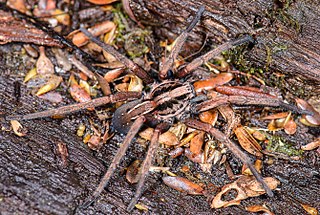
Miturgidae is a family of araneomorph spiders that includes nearly 170 species in 29 genera worldwide. First described by Eugène Simon in 1886, it has been substantially revised, including of previous family "Zoridae" as subfamily "Zorinae" and excluding the family "Xenoctenidae". Several genera have also been removed, such as the large genus Cheiracanthium, which was transferred to the Cheiracanthiidae.
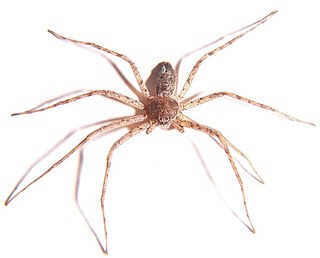
Philodromidae, also known as philodromid crab spiders and running crab spiders, is a family of araneomorph spiders first described by Tord Tamerlan Teodor Thorell in 1870. It contains over 600 species in thirty genera. Most are dull colored- brown, gray, yellowish or mottled with a leaf-like cardiac mark on the anterior dorsal abdomen, and seldom reach above 10 millimetres (0.39 in) long. None of the species build webs, but they do use silk for draglines and egg sacs.
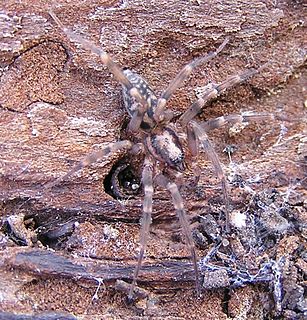
Liocranidae is a family of araneomorph spiders first described by Eugène Simon in 1897. They are one of several groups called "sac spiders". The holarctic genus Agroeca is the best-known, but it also includes various genera of more obscure spiders that still lack a diagnosis. Two species in the North American genus Neoanagraphis are found in the extremely dry conditions in the Mojave, Sonoran and Chihuahuan deserts. Females live in animal burrows while males wander and are the ones most often caught in pitfall traps.

Titanoecidae is a family of araneomorph spiders first described by Pekka T. Lehtinen in 1967. It is fairly widespread in the New World and Eurasia with five genera and more than 50 species worldwide. These are mostly dark-colored builders of "woolly" (cribellate) silk webs. Several species are found at relatively high altitudes in mountain ranges and may be very common in such habitats.

Tord Tamerlan Teodor Thorell was a Swedish arachnologist.

Cheiracanthium, commonly called yellow sac spiders, is a genus of araneomorph spiders in the family Cheiracanthiidae, and was first described by Carl Ludwig Koch in 1839. They are usually pale in colour, and have an abdomen that can range from yellow to beige. Both sexes range in size from 5 to 10 millimetres. They are unique among common house spiders because their tarsi do not point either outward, like members of Tegenaria, or inward, like members of Araneus), making them easier to identify. The name is a reference to the backwardly directed process on the cymbium of the male palp. The species epithet is derived from the Greek Ancient Greek: χείρ, romanized: cheir, meaning "hand", and Acanthium, a genus of thorny-stemmed plants.

Ozyptila is a genus of crab spiders that was first described by Eugène Louis Simon in 1864. It has been misspelled as "Oxyptila" in multiple accounts.
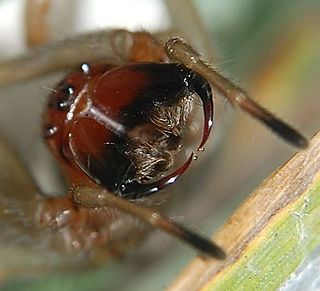
Cheiracanthium punctorium, one of several species commonly known as the yellow sac spider, is a spider found from central Europe to Central Asia. They reach a length of about 15 mm, and their bite can penetrate human skin; the bite has been compared to a wasp sting, perhaps a bit more severe, although susceptible persons can have stronger reactions, like nausea. Females build an egg sac of about 4 cm in high grass. It opens below and is aggressively defended.

Runcinia is a genus of crab spiders that was first described by Eugène Louis Simon in 1875. The former R. elongata is a synonym of Thomisus elongatus.
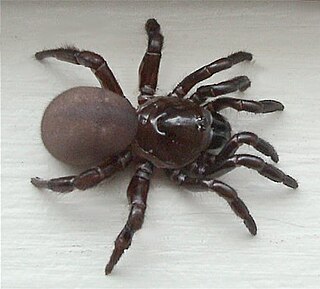
Ummidia is a genus of mygalomorph spiders in the family Halonoproctidae, and was first described by Tamerlan Thorell in 1875.
Dasumia is a genus of woodlouse hunting spiders that was first described by Tamerlan Thorell in 1875.

Cheiracanthiidae is a family of araneomorph spiders first described by Vladimir Wagner in 1887. The synonym Eutichuridae was used for a long time, but Cheiracanthiidae has priority. The largest genus currently recognized as belonging to this family is Cheiracanthium, which has previously been placed in both the Clubionidae and the Miturgidae.
Minicia is a genus of dwarf spiders that was first described by Tamerlan Thorell in 1875.
Sagana rutilans is a species of spiders in the family Liocranidae. It was first described in 1875 by Thorell. As of 2020, it was the only species in the genus Sagana. It is found from Europe to Georgia. The genus name SaganaThorell, 1875 is a junior homonym of the moth genus SaganaWalker, 1855, so the combination Sagana rutilans is unavailable, but as of October 2020 was still used in the World Spider Catalog.
Pardosa elegans is a species of wolf spiders found in Russia.
Talaus elegans is a species of crab spiders in the family Thomisidae. It is found in Sumatra.
Telamonia elegans is a species of spiders in the jumping spider family, Salticidae, found in rain forest in Asia. It is found in Myanmar, Vietnam and Indonesia.










